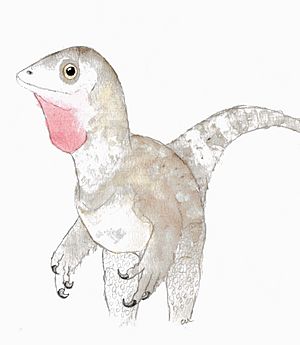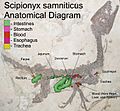Scipionyx facts for kids
Quick facts for kids ScipionyxTemporal range: Upper Cretaceous, 113 mya
|
|
|---|---|
 |
|
| Fossil specimen, Museo Civico di Storia Naturale di Milano | |
| Scientific classification | |
| Kingdom: | |
| Phylum: | |
| Class: | |
| Superorder: | |
| Order: | |
| Suborder: | |
| Genus: |
Scipionyx
|
| Species: |
S. samniticus
|
| Binomial name | |
| Scipionyx samniticus Sasso & Signore, 1998
|
|
Scipionyx samniticus is a very special dinosaur fossil. It's a tiny meat-eating dinosaur, called a theropod, found in Cretaceous rocks in southern Italy, close to Naples. Even though it was found way back in 1981, people didn't realize how important it was until 1994.
This fossil is amazing because it shows parts of the dinosaur's inside, like its organs and muscles! Usually, soft parts of animals rot away before they can turn into fossils. This makes Scipionyx super rare. Studying this fossil can teach us a lot about how dinosaurs were built and how their bodies worked.
This dinosaur was a baby, only about 9.5 inches (24 cm) long. It lived about 113 million years ago, during the Cretaceous period. At that time, it lived near a shallow lagoon, which is like a calm, shallow body of water. Scientists think it might be related to another dinosaur called Compsognathus.
Images for kids
See also
 In Spanish: Scipionyx samniticus para niños
In Spanish: Scipionyx samniticus para niños











